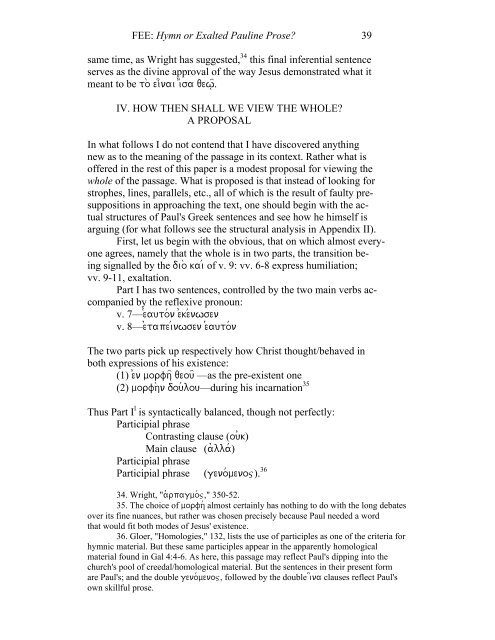Philippians 2:5-11: Hymn or Exalted Pauline Prose? - Institute for ...
Philippians 2:5-11: Hymn or Exalted Pauline Prose? - Institute for ...
Philippians 2:5-11: Hymn or Exalted Pauline Prose? - Institute for ...
Create successful ePaper yourself
Turn your PDF publications into a flip-book with our unique Google optimized e-Paper software.
FEE: <strong>Hymn</strong> <strong>or</strong> <strong>Exalted</strong> <strong>Pauline</strong> <strong>Prose</strong>? 39<br />
same time, as Wright has suggested, 34 this final inferential sentence<br />
serves as the divine approval of the way Jesus demonstrated what it<br />
meant to be to_ ei]nai i!sa qew| =.<br />
IV. HOW THEN SHALL WE VIEW THE WHOLE?<br />
A PROPOSAL<br />
In what follows I do not contend that I have discovered anything<br />
new as to the meaning of the passage in its context. Rather what is<br />
offered in the rest of this paper is a modest proposal f<strong>or</strong> viewing the<br />
whole of the passage. What is proposed is that instead of looking f<strong>or</strong><br />
strophes, lines, parallels, etc., all of which is the result of faulty presuppositions<br />
in approaching the text, one should begin with the actual<br />
structures of Paul's Greek sentences and see how he himself is<br />
arguing (f<strong>or</strong> what follows see the structural analysis in Appendix II).<br />
First, let us begin with the obvious, that on which almost everyone<br />
agrees, namely that the whole is in two parts, the transition being<br />
signalled by the dio_ kai& of v. 9: vv. 6-8 express humiliation;<br />
vv. 9-<strong>11</strong>, exaltation.<br />
Part I has two sentences, controlled by the two main verbs accompanied<br />
by the reflexive pronoun:<br />
v. 7—e(auto&n e)ke&nwsen<br />
v. 8—e)tapei&nwsen e(auto&n<br />
The two parts pick up respectively how Christ thought/behaved in<br />
both expressions of his existence:<br />
(1) e)n m<strong>or</strong>fh= qeou= —as the pre-existent one<br />
(2) m<strong>or</strong>fh_n dou&lou—during his incarnation 35<br />
Thus Part I l is syntactically balanced, though not perfectly:<br />
Participial phrase<br />
Contrasting clause (ou)k)<br />
Main clause (a)lla&)<br />
Participial phrase<br />
Participial phrase (geno&menoj). 36<br />
34. Wright, "a(rpagmo&j," 350-52.<br />
35. The choice of m<strong>or</strong>fh& almost certainly has nothing to do with the long debates<br />
over its fine nuances, but rather was chosen precisely because Paul needed a w<strong>or</strong>d<br />
that would fit both modes of Jesus' existence.<br />
36. Gloer, "Homologies," 132, lists the use of participles as one of the criteria f<strong>or</strong><br />
hymnic material. But these same participles appear in the apparently homological<br />
material found in Gal 4:4-6. As here, this passage may reflect Paul's dipping into the<br />
church's pool of creedal/homological material. But the sentences in their present f<strong>or</strong>m<br />
are Paul's; and the double geno&menoj, followed by the double i#na clauses reflect Paul's<br />
own skillful prose.
















